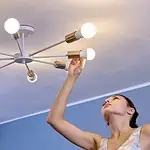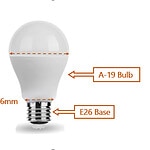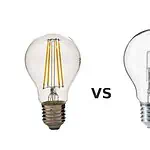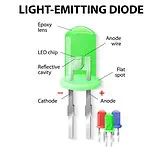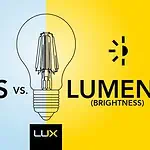Most of the A19 bulbs come with an E26 base; this is where the confusion arises if they are the same thing. However, the answer is no; E26 and A19 refer to two different facts about a fixture, and so they aren’t the same.
E26 refers to the size of the bulb base, whereas A19 defines the shape of the bulb. So, the two terms are not in the same category for a side-by-side comparison. Yet, for clarification, you should know what they actually indicate. All varieties of bulbs that have a 26mm Edison base are known as E26 bulbs. In contrast, the Edison screw bulb that has a pear-like shape with a standard dimension of 2.4 inches (widest part of the bulb) is an A19 bulb. Therefore, an E26 bulb and an A19 don’t refer to the same thing, but an A19 bulb can also be an E26 bulb.
No more confusion with these terms; I have pointed out all the facts that you must know to differentiate them and explore how they relate. So, let’s dig in:
What Is An E26 Bulb?
An E26 bulb refers to the standard base size of a bulb with a diameter of 26mm. The ‘E’ of E26 bulbs stands for Edison Screw, and ‘26’ stands for the size of the base. They are also known as Medium Edison Screw bulbs (MES) or standard bases. You will find them as the most used base variants in the US, Canada, and some North American countries. These bulbs can be halogen, incandescent, CFL, or LED. Again, in terms of design, they can be of different variants- pear shape, round, etc. That is, any bulb that has an Edison Screw base with a 26mm diameter is an E26 bulb. To learn more, check this- What Is An E26 Bulb? Here’s What You Need to Know.
Advantages Of E26 Bulb
The major advantage of using an E26 bulb is that they are considered the standard size, so the port is available in most locations. Here, I am pointing out the pros of using an E26 bulb-
- Compatible with most bulbs, and you can easily find the suitable fixture for an E26 base
- Easy to install and doesn’t require any additional tools to mount
- Strong fitting with screwing mechanism
- Can withstand vibrating locations
- Dust- and moisture-proof since nothing can get near the contact point thanks to the snug fit
- Reduced chance of electrical malfunctions
What Is An A19 Bulb?
A19 indicates the shape of the bulb. The letter ‘A’ defines the classic shape of the bulb that resembles an upside-down pear. The number ’19’ indicates the diameter of the widest part of the bulb, which is 19/8, approximately 2.4 inches. However, Some countries use a millimeter scale instead of inches to label the bulbs, so they refer to A19 bulbs as A60 bulbs. So, to be more specific, A19 is described as roughly pear-shaped, measuring between 100 and 110 mm in length and 60 mm in width. Nevertheless, the base of an A19 bulb is 26mm in diameter and has an Edison screw format. That is, A19 bulbs have an E26 base, and this is where they relate.
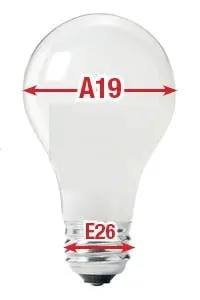
Advantage Of A19 Bulb
The advantages that you will get from purchasing A19 bulbs are as follows-
- Emit less heat
- Provides even lighting
- High lumen ratings
- Fixtures are available in different technologies- incandescent, CFL, or LED
- Produce omnidirectional lighting
- Ideal for decorative lighting
All A19 Bulbs Are E26 Bulb, But All E26 Aren’t A19
A19 bulb refers to the shape of the bulb that resembles an upside-down pear, whereas E26 determines the size of the bulb base. So, keeping the diameter of the base 26mm, the bulb can be of any shape. It could be round, oval, pear, spherical, or any fancy design. Thus, all E26 bulbs are not A19, which stands for a specific shape.
In contrast, A19 bulbs come with a 26mm diameter base, which refers to an E26 bulb. According to US standards, an A19 bulb is designed to tolerate 120V, which matches the voltage of an E26 base. That is why all A19 bulbs are E26, but not all E26 bulbs are A19.
NB: As per European standards, A19 bulbs in those regions use an E27 base compatible with 220-240 volts. Besides, some can also have E12 (candelabra) or GU24 bases. But E26 is the most common base for A19 bulbs.
E26 Vs. A19 – Know The Difference
It isn’t right to compare E26 and A16 as they don’t indicate similar factors. The main difference between them is that- one deals with the base size while the other indicates bulb shape. Besides, you should know some other facts about E26 and A19 bulbs to differentiate them; these are as follows-
Variants
E26: As E26 refers to the base, not the bulb, they are available in different variants. Besides the US and North American countries, these bulbs are also used in Japan. They are available in every shape, size, and technology. They can be incandescent, CFL, LED, or halogen bulbs. Again, based on design, they can be globe bulbs, spherical bulbs, any A-type bulb, etc.
A19: The shape of an A19 bulb indeed reminds us of the incandescent variants with a filament inside, but now these fixtures are available in advanced technologies rather than the traditional ones. You will find A19 bulbs in compact fluorescent light (CFL) or LED format, too. These variants are far more energy-efficient and safe than typical A19 ones. Here is a difference between these three variants of A19 bulbs-
| Criteria | Incandescent | CFL | LED |
| Wattage (for 1000–1400 lumens) | 75W | 18–22W | 12–13W |
| Life Span | 1000 hours | 15,000 hours | 50,000 hours+ |
| Pros | CheapIdeal for cozy lighting | Cheaper than LEDEnergy efficient than incandescent bulbs | Energy efficient Durable and lasts longer |
| Cons | Consumes more energy | Poor color rendering indexingNot as efficient as LEDs | More expensive than other variants |
Standard Dimensions
E26: The International Electrotechnical Commission (IEC) under standard 7004-21A-3 regulates the dimension of the E26 bulb base. Below, I am adding the standard dimension of an E26 bulb-
| T1: Minimum dimension of 19.56 mm |
| T: Minimum dimension of 19.56 mm |
| H: Minimum dimension of 9.14 mm and a maximum dimension of 11.56 mm |
| L: Minimum dimension of 15.24 mm and a maximum dimension of 17.01 mm |
| C: Minimum dimension of 3.25 mm |
| r: Radius of 1.191 mm |
| d1: Diameter of 24.72 mm |
| d: Minimum diameter of 26.05 mm and a maximum diameter of 26.41 mm |
A19: The dimensions of A19 bulbs may vary by just a millimeter or less. Yet, these little variations can impact the light output. American National Standards Institute (ANSI) has fixed some standard dimensions for A19 bulbs based on varying wattage ratings. These are as follows-
| Wattage | Maximum Diameter (in Millimeters) | Maximum Length (in Millimeters) |
| 100W | 69.5 | 112.7 |
| 75W | 69.5 | 112.7 |
| 60W | 69.5 | 112.7 |
| 50W Type 211 | 69.5 | 112.7 |
| 40W Type 211 | 69.5 | 112.7 |
| 40W Type 210 | 69 | 108 |
| 50W Type 206 | 68 | 100 |
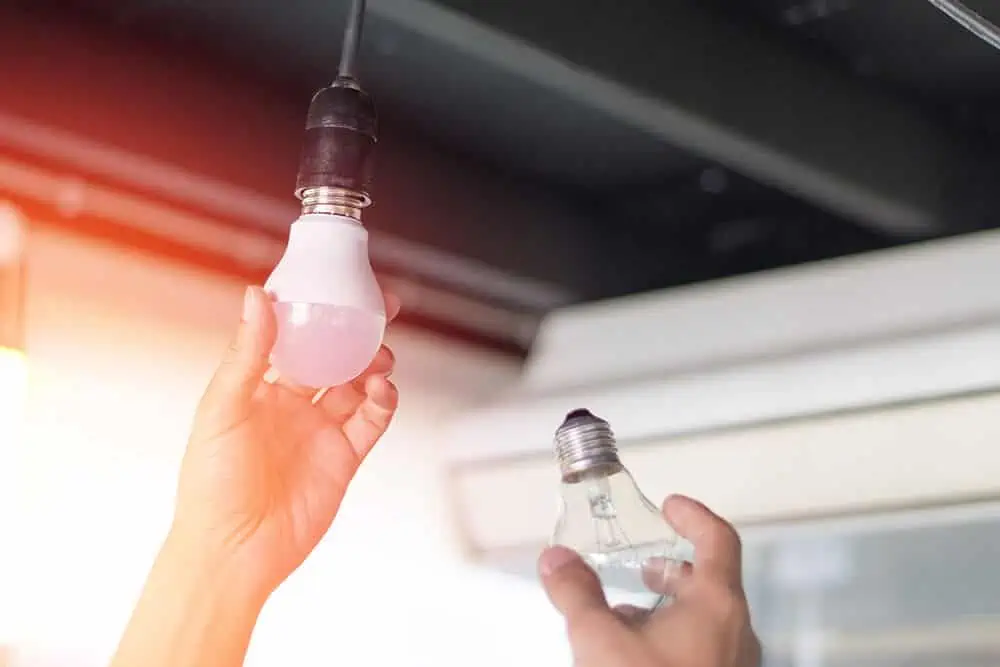
Compatibility and Interchangeability
E26: E26 bulbs are compatible with an E26 base that supports a 120V (US). Any fixture with a 26mm diameter Edison screw base will fit in an E26 socket. However, sometimes you can use an E26 bulb to fit in an E27 socket as they only differ by 1mm. Yet this is not appropriate as there are voltage differences, and the fixture may get loosened. These bulbs are available in incandescent, CFL, halogen, and LED formats. So, if you have an E26 incandescent bulb fitted in your house, you can interchange it with an E26 bulb. This helps you to modify the light technology and get better efficiency.
A19: The A19 bulbs are compatible with E26 bases. But from the perspective of a European country, A19 bulbs are compatible with E27 bases. This is because the standard household voltage in this region is 220V, which matches E27 bulbs. However, you can interchange them with an A60 bulb, though they are technically the same. The difference is that in A19 bulbs, the dimensions are measured by inch, and in A60, they are measured by mm. Technically, both the fixtures are identical. So, if you have an A19 socket in your house and you find one labeled A60, feel confident about purchasing it.
Application
E26: You will find E26 sockets in residential and commercial places. For indoor or outdoor lighting, E26 bulbs are widely used. Besides, E26 bulbs with smart features, such as Wi-Fi or Bluetooth connectivity, are used in smart lighting systems. Apart from these, E26 lights are also used in industrial applications.
A19: A19 bulbs are popular for decorative lighting. For instance, if you look at Christmas decorations, you will find the use of these bulbs. Besides, A19 fixtures are used in lamps, ceiling lights, wall sconces, etc.
E26 Vs. A19: Quick Differentiating Chart
| Criteria | E26 | A19 |
| Refers To | Base of the bulb | Shape of the bulb |
| Shape | Any shape of bulb that has a 26mm base; it could be an A19 bulb, BR30 bulb, PAR38 bulb, etc. | Pear-like shape |
| Application | Household, commercial, outdoor, industrial, decorative, task lighting | A19 bulbs can be used in various lamps, ceiling fixtures, wall sconces, and other lighting applications equipped with E26 sockets. |
| Versatile | The versatile base is compatible with various bulb shapes. So, you will find a wide range of designs in E26 bulb type. | It defines a specific shape, so all A19 bulbs will look alike, whether it’s an incandescent or an LED. |
Factors To Consider When Choosing E26 And A19
Before buying any E26 and A19 bulbs here are the facts that you should consider:
Consider The Base Type
The foremost consideration is what base you need for your installation. If you purchase an E26 bulb and see the socket in your house doesn’t match the size, it is a complete waste. So, to avoid such a situation, first, see if the socket fits an E26 bulb or not. Once you are sure of the base, you can get any E26 bulb of your desire. It could be an A19 bulb or something else that has an E26 base.
Wattage and Lumen Rating
High-wattage bulbs give off brighter light. But here, energy efficiency and price matter. Usually, the E26 and A19 bulbs with high wattage are more expensive than the ones with low wattage. Besides, you should consider lighting technology. At the same wattage ratings, LED lights can give off more lumen than incandescent bulbs. That is, you can get the same light output at lower watts with LED E26 or A19 bulbs. For example- a 9-watt incandescent bulb is equivalent to a 1-watt LED bulb.
Color Temperature
Decide what color fixture you want. Both E16 and A19 bulbs are available in all color temperatures– warm to cool. If you want to create a cozy vibe, use warm bulbs. Usually, warm E26/A19 bulbs are used in chandeliers and lamps. Again, for a modern or more subtle ambiance, go for cool lighting.
Dimming Capabilities
Dimmable E26 or A19 bulbs add extensive convenience to adjust the intensity of the light’s brightness. However, the fixtures with dimming fixtures are expensive as they require an additional component to manufacture. So, if your budget is low, you can go for a non-dimmable fixture, but for better control over intensity, I suggest you choose one with a dimming feature.
Lifespan
When it comes to lifespan, nothing can beat LED E26 and A18 bulbs. They last much longer than incandescent, halogen, or CFL bulbs. Below, I am adding a comparison chart from different variants of E26 and A16 bulbs to help you choose the one with the highest lifespan-
| Type of E26 & A19 Bulb | Incandescent | Halogen | CFL | LED |
| Lifespan | 1000 hours | 2000 hours | 10,000 to 15,000 hours | 50,000 hours+ |
Thus, with LED E26 and A19 bulbs, you won’t need to replace the fixture frequently. They last longer and need minimal repairing or replacement than other forms of bulbs.
Certifications
Certifications matter to ensure the bulb you purchase is safe and environmentally friendly. Check whether the fixture is marked as Energy Star; this ensures energy efficiency. Though these bulbs are expensive, you will get quality bulbs that last longer and save your bills. Besides, there are some other essential certifications that you must consider while purchasing an E26 or A9 bulb. These are- DLC Approved, EnergyStar®, ETL Certification, FCC Certification, RoHS Certification, UL Listed, etc. For more information about certifications, check this- The Certification of LED Strip Lights.
Brand
The price of fixtures varies from brand to brand. Reputed brands used high-quality materials that increased their price range. However, affordability doesn’t always mean cheap quality. You should research well to get quality products at cheap prices. Here are some popular brands that are famous for manufacturing E26 and A19 bulbs-
- Philips
- Cree
- Sylvania
- GE Lighting
- EcoSmart
- Feit Electric
Energy Efficiency
Energy efficient fixtures can reduce your electricity bills by many times. A LED E26/A19 bulb consumes about 75% less energy than an incandescent bulb. They convert 80% of energy to light, and only the remaining 20% is converted to heat. This makes them highly energy efficient and saves your electricity bills. Besides, due to less heat emission, they operate at minimum temperatures. Like incandescent E26 bulbs, you won’t face overheating issues with the LED ones.
Cost
A26 and A19 bulbs can be of varying types- incandescent, halogen, CFL, or LED. The prices of these bulbs are different. Usually, as you move from traditional to advanced bulbs, the price increases. However, they are cost-effective compared to incandescent or halogen bulbs in the long run. Below, I’m adding the prices of different types of E26 and A19 bulbs for different wattage ratings-
| Type of E26 or A19 bulb | Watts | Price |
| Incandescent($0.50 to $5) | 60-watt | $0.50 to $1 |
| 100-watt | $2 to $5 | |
| Halogen($2 to $10) | 60-watt | $2 and $4 |
| 100-watt | $8 and $10 | |
| LED Bulb ($1 to $30 or more) | 60-watt | $1 to $3 |
| 100-watt | $10 to $20 |
Recommended E26 And A19 Bulbs
Below, you will find the most popular and well-reputed A19 and E26 bulbs-
- Philips Dimmable Frosted A19 LED Bulbs (4-Pack)
- Feit Electric Enhance 60W Replacement Soft White A19 Dimmable LED Light Bulb
- Philips Ultra Definition 60W Replacement A19 Dimmable LED Light Bulb
- Feit Electric Enhance Daylight A19 Dimmable LED Light Bulb
- Ralbay E26 4W Half Chrome Light Dimmable G25(G80)
- Sigalux Edison Bulbs, E26 LED Bulb 60 Watt Dimmable Vintage Light Bulbs
- WiZ 60W A19 Color LED Smart Bulb – Pack of 2 – E26
FAQs
E26 bases are standard size in the US, North America, Canada, and Japan. You can use an E26 light bulb anywhere that has an Edison screw base of 26mm diameter. These fixtures are suitable for all types of applications- residential, commercial, and industrial zones.
The E26 bulb is an Edison screw light variant. The base of these bulbs has a screw mechanism, as invented by Thomas Edison. The screw’s threads serve as neutral electrical pathways, transmitting electricity from the socket to the incandescent or halogen bulb’s filament.
There is nothing to interchange between an A19 bulb and an E26 bulb. E26 is the base of the bulb with 26mm diameter. An A19 bulb is a pear-shaped bulb that usually comes with an E26 base. So, there is no option to replace one with another.
A19 doesn’t refer to the bulb base; rather, it indicates the shape of the bulb. They usually have an E26 base, which is considered standard in the US, Northern America, Canada, Japan, and a few more countries. However, in Europe, A19 bulbs come with an E27 base that operates at a high voltage rating compared to an E26 base.
Yes, the E26 bulb has a 26mm base that is considered the standard size of socket. In the USA, sockets in residential and commercial areas are designed for E26 bulbs. Besides, as the screwing mechanism of these bulbs gives a robust fit, they are also used in industrial zones.
If your A19 bulb has an E27 base, then you can use it on an E27 socket without any hesitation. But if your A19 bulb has an E26 socket, then it’s a matter of concern. The E27 sockets are designed for running bulbs at 220V-240V. However, A19 bulbs with an E26 base are designed to operate at 120V. Thus, your bulb can get damaged by high voltage passing if you use an A9 bulb with an E26 base to an E27 socket. However, they can fit into the socket as a 1mm difference in diameter will not affect much, yet it won’t be as strongly fitted as expected.
No, not all A19 bulbs are A19. Only the pear-shaped bulbs with 2.4-inch diameter (widest part) are referred to as A19 bulbs. So, as bulbs come in different shapes and sizes, not all bulbs can be A19.
In the US, the E26 bulb is considered standard and operates at 120 V. Whereas in Europe, the E27 is the standard bulb size. In these regions, the fixtures are designed to operate at 220V. So, before purchasing any bulb, consider your location to choose between E26 and E27 bases.
The Bottom Line
To conclude, the E26 bulb and A19 don’t mean the same thing. A19 bulbs mostly have E26 bases and are pear-like in shape. These bulbs are popular for decorative lighting, chandeliers, lamps, etc. On the other hand, any type of bulb of any shape or design can be an E26 bulb having a base of 26 mm with an Edison screw pattern. These bulbs are considered standard bulbs in the US, Northern America, Canada, and Japan. You can use these bulbs for residential and commercial applications. Besides, the screwing design of the Edison bulbs makes them suitable for vibrating areas in industrial zones.
However, always go for the LED when purchasing E26 and A19 bulbs. The incandescent or fluorescent variants are not energy efficient. You will need to replace them frequently and pay high electricity bills. Therefore, if you have a traditional bulb, switch to LED ASAP!
